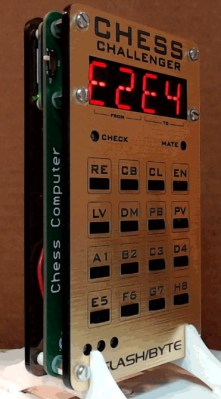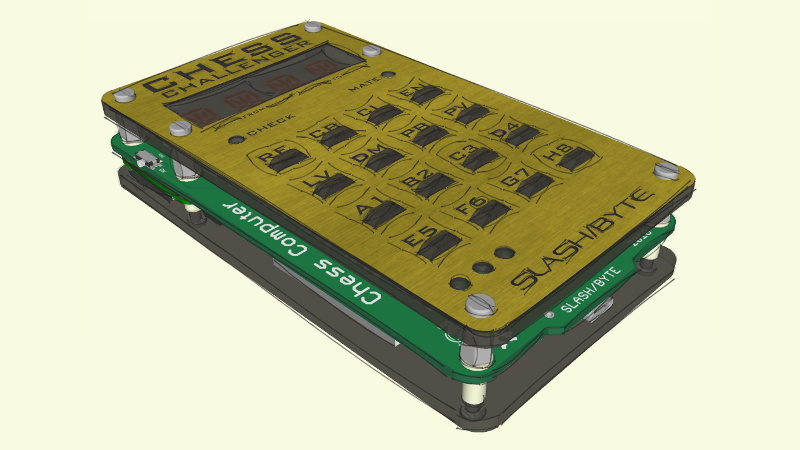If you imagine somebody playing chess against the computer, you’ll likely be visualizing them staring at their monitor in deep thought, mouse in hand, ready to drag their digital pawn into play. That might be accurate for the folks who dabble in the occasional match during their break, but for the real chess aficionados nothing beats playing on a real board with real pieces. Of course, the tricky part is explaining the whole corporeal thing to a piece of software on your computer.
 Enter the “Chess Challenger” by [slash/byte]. Modeled after a commercial gadget of the same name from 1978, his retro-themed open hardware design utilizes the Raspberry Pi Zero and modern chess software to bring the vintage concept into the 21st century. With the Chess Challenger and a standard board, the player can face off in an epic battle of wits against the computer without risk of developing carpal tunnel. We can’t guarantee though that a few boards might not get flipped over in frustration.
Enter the “Chess Challenger” by [slash/byte]. Modeled after a commercial gadget of the same name from 1978, his retro-themed open hardware design utilizes the Raspberry Pi Zero and modern chess software to bring the vintage concept into the 21st century. With the Chess Challenger and a standard board, the player can face off in an epic battle of wits against the computer without risk of developing carpal tunnel. We can’t guarantee though that a few boards might not get flipped over in frustration.
The pocket sized chess computer uses a “sandwich” style construction which shows off the internals while still keeping things reasonably protected. All of the electronics are housed on the center custom PCB which features a HT16K33 driver for the dual LTP-3784E “starburst” LED displays, a MCP1642B voltage regulator, 16 TL3305 tactile switches for the keyboard, and a MCP73871 battery management chip for the 3.7 volt lithium-ion battery that powers the whole show. The Pi Zero itself connects to the board by way of the GPIO header, and is mechanically supported by the standoffs used to hold the device together.
On the software side of things, the Pi is running the mature Stockfish open source chess engine. In development now for over a decade, this GPL licensed package aims to deliver a world-class chess gameplay on everything from smartphones to desktop computers, and we’ve seen it pop up in a number of projects over the years. [slash/byte] has provided a ready to flash SD card image for the Raspberry Pi, and even provides detailed installation and setup instructions which guide you through some of the more thorny aspects of the setup such as getting the Pi running from a read-only operating system so that abrupt power cuts don’t clobber the filesystem.
Over the years, some of the most impressive projects we’ve seen revolved around playing chess, and this latest entry by [slash/byte] is no exception. Another example of the lengths the chess community will go to perfect the Game of Kings.
















Okay. That front panel is really pushing my buttons. In the best possible way. Pure class.
I’m still mad that they discarded a hundreds year old chess notation system, that I grew up with, to make things easier to program.
1. P – K4
Having learn a new notation is part of the “challenge”?
B^)
Like RPN?
Touche’
Just a little clarification: Standard (“P-K4”) notation was discarded because it was occasionally ambiguous. Imagine a situation where either knight could capture the same piece. Or perhaps two pawns could capture the same opposing piece. Algebraic notation (“E4”) is clearly less ambiguous. As far as I am aware, the prevalence of algebraic notation has nothing to do with programming. In ’77 I was playing chess against an IBM 370 running code in APL and used “standard” notation. As I recall, the code used notation only in communicating with the human (l)user, not internally for any algorithm.
P.S.: I thought RPN rocked… But now my HP calculator has an “=” key!! ????
I should add: there’s room for ambiguity in any notation, but there tends to be less with algebraic.
have you an example where algebraic notation is ambigous please ?
Are these “starburst” LED displays different than “Union Jack”?
Just depends on which made up name you were taught, I suppose.
I wish I had the patience/time to fork this project and add an OLED display on it. Come on, guys, it’s 2019! Let’s take advantage of the newer/better/prettier components we have available now.
This comment is really impressive to me as it not only shows you completely ignored the theme of the device (to replicate a piece of 70’s tech), but at the same time admit you’re too lazy to make these supposed necessary “improvements”.
Even for a HaD comment, this is an incredibly inane statement. It’s truly an accomplishment in its own way.
And you must be fun at parties.
Where can I purchase this? Link pls!
Yeah I want it so badly that I started buying retro electronics chess